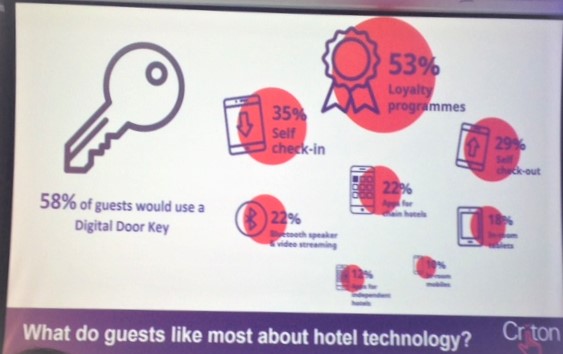- This year’s BCA Conference & Exhibition followed the theme “Tomorrow’s World: The Future of Technology, Innovation and Space”.
- During the event attendees learned that the Business Center Association (BCA) will transition to the Flexible Space Association (FSA).
- Key themes addressed by keynote speakers included technology, design, wellness, Brexit, and more.
Tuesday 14th May saw the return of the BCA Conference & Exhibition in London, an annual event that brings together flexible workspace operators, suppliers and occupiers for a packed day of industry information and insights.
This year’s 29th annual Conference followed the theme of “Tomorrow’s World: The Future of Technology, Innovation and Space”. Naturally, technology took a starring role in each speaker presentation. But, it soon became evident that while technology and digital innovation is having a significant impact on all facets of flexible workspace — from demand and client requirements to bookings and day-to-day operations — there is a fine line between what can and should be automated, and what should remain an opportunity for human interaction.
Allwork.Space attended the BCA Conference and came away with the following key highlights.
1. The BCA is changing.
The Business Centre Association has been the UK voice of the industry since 1989. But a lot happens in 30 years, particularly in a sector that’s evolving as quickly as ours. Three decades ago, business centres and serviced offices (or executive suites in the US) were gradually gaining traction. Then coworking exploded onto the scene, and somewhere in amongst the myriad of hybrid spaces that began populating our sector, it became apparent that the term ‘business centre’ no longer does our industry justice.
In recent years ‘flexible workspace’ has become the preferred catch-all term, and so, BCA Executive Director Jane Sartin announced during her opening speech that the BCA will soon transition from Business Centre Association to Flexible Space Association (FSA) to reflect the ever-broadening types of workspace now offered by the sector.
2. The future workplace is about wellness and inclusivity.
While this year’s Conference focused on technology, innovation and space, keynote speaker Philip Ross from UnWork had other priorities: wellness and inclusivity.
He discussed how lifestyle is taking centre stage in today’s workplace, which ranges from homely office headquarters complete with quiet lounges and woodburning stoves, to roof terraces with allotments, vegetable plots and even chicken coops, tended by workplace occupants. Biophilia has an important role to play, according to Ross, but if you can’t bring the outside in, you can always opt for a digital solution, such as the incredible waterfall lobby at Salesforce’s offices in San Francisco.

Watch a video of the wall in action here: https://vimeo.com/175865167
3. How The Office Group gained its “firepower”
One of the most engaging presentations of the day was an interview with The Office Group’s Charlie Green and Olly Olsen, by Emma Jones MBE of Enterprise Nation. Digging into the founders’ story, Jones asked the question, did Blackstone’s much-publicised investment in The Office Group in 2017 change the nature of the business? To which Green replied that although it was a tough and painstaking decision at the time, “it was the best thing we could have ever done”.
This, Green and Olsen replied, was because the market was changing rapidly at that time. WeWork was growing fast, there was a flood of new market entrants, real estate companies were beginning to take notice of flexible space, and London was becoming too hot to handle. Having the backing of Blackstone gave the company the “firepower” it needed, and helped secure a strong future for TOG in an increasingly competitive landscape.
4. Secondary markets – the next big thing?
In a fascinating and data-rich presentation by John Williams and James Rankin of the Instant Group, one of the most notable takeaways is that secondary markets are gaining traction. As demand for flexible workspace continues to grow at pace, highly competitive markets such as London and New York are becoming too expensive — not just for operators, but for occupiers too. In the event of a downturn, Williams and Rankin suggested that tertiary markets will increasingly become in demand as clients — and particularly those seeking larger flexible spaces — look for spaces that are cheaper, closer to home, less congested, and greener. This trend is one to watch.
5. Brexit. We’re sick of hearing about it, but what is its impact on flexible space?
As Jonathan Brenton, the CBI’s Principal Policy Advisor on EU Negotiations, pointed out, the EU has become ingrained in every nook and cranny of UK life over a period of 40 years, and we cannot expect to unpick every thread within a couple of years. Frustratingly, this means there’s still a long road ahead.
That said, it seems Brexit isn’t having much impact on flexible space. In a panel featuring Brenton, Bizspace’s Emma Long, Landmark’s John Spencer and Jonathan Weinbrenn of Bespoke, the overall consensus is that If anything, Brexit is having a positive impact on the industry as businesses seek the reassurance of workplace flexibility amid ongoing uncertainty. In some cases, demand has even been described as “buoyant” as clients seek out flexibility, agility, and mobility — which is something that conventional workplace options can’t deliver.
6. Hospitality and flexible workspace are coming together.
Julie Grieve, founder of hospitality app Criton, discussed some of the important lessons that flexible workspace can learn from hotels, particularly the service touchpoints and how technology can help smooth the guest’s interaction with your brand.

“We shouldn’t ask what we as operators want from technology, we should be asking what our clients or guests want,” she said. “We should be challenging our technology providers to solve the problems our clients, and therefore we, are facing.”
One way to learn what clients want from the workplace experience is for operators to step into their clients’ shoes and carry out the complete end-to-end journey of finding a space, from initial online search and website landing page, to turning up and taking a tour.
“I challenge all of you to make a booking in your own spaces. Do it often enough and you’ll soon find the problems that your customers face.”
7. Design can be beautiful, but more importantly, it should be functional.
There are endless discussions about flexible workspace design. What’s key above all else, said Inga Taylor of Opstech Services, is that workspace design must be functional. Otherwise what’s the point?
By functional, it should provide a seamless user experience for the client — but it should also serve its function for the operator. In other words, design should enable you to maximise revenue from the space you have available by helping you to create a versatile environment with agile, mobile furniture that can enable each space to serve multiple purposes.


 Dr. Gleb Tsipursky – The Office Whisperer
Dr. Gleb Tsipursky – The Office Whisperer Nirit Cohen – WorkFutures
Nirit Cohen – WorkFutures Angela Howard – Culture Expert
Angela Howard – Culture Expert Drew Jones – Design & Innovation
Drew Jones – Design & Innovation Jonathan Price – CRE & Flex Expert
Jonathan Price – CRE & Flex Expert











